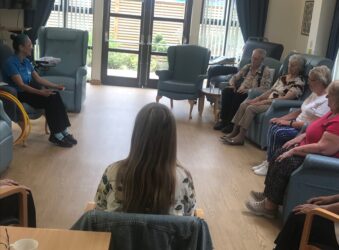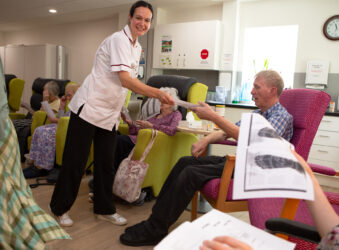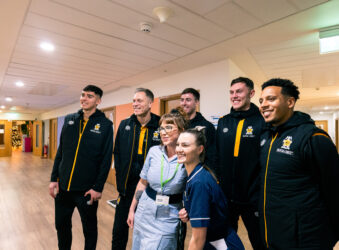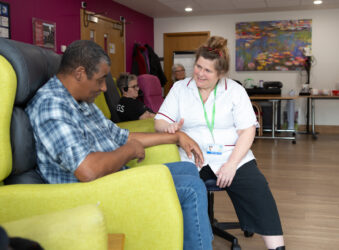Kate – Complementary Therapist
Share this story
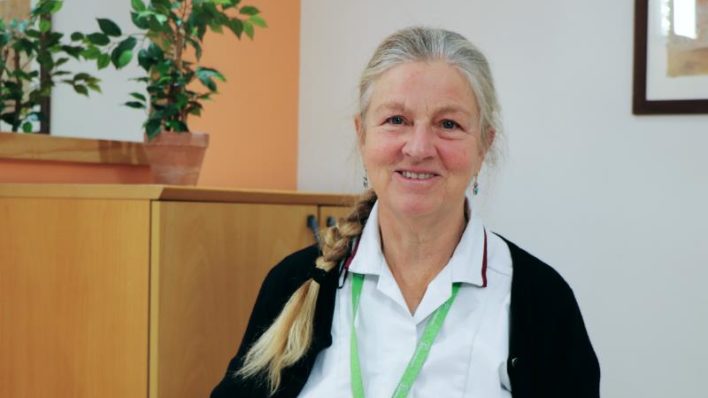
Kate is one of the Hospice’s Complementary Therapists and she works closely with the Hospice at Home team…
Where are you based?
My role is split across all of the different areas at the Hospice but one day a week I’m based with Hospice at Home and I do other hours adhoc as needed. On the days that I’m working with Hospice at Home, I’m based in the Arthur Rank Community Team office.
What do you actually do?
Once the Hospice at Home team has done their early morning handover, there will be referrals for me. These will come either from the night team – and the Healthcare Assistant who’s been with the family overnight – or from the day team, who’ve spoken to the family over the phone.
Usually they give me the contact details for the patient. I call them to find out if it’s a good day and if it’s something they still want, then arrange a time for a visit.
Sometimes the recommendation isn’t for the patient: it might be for the family or carer. We have a very holistic approach to care for the whole family. Once I did a session of gentle hand and foot massages, for five family members!
What’s special about your role?
For patients there is often lots of physical intervention, but as a complementary therapist, I’m not doing that. I meet the person as they are, beyond their illness. For the family it can be the same thing. You go in offering something else, which is not about the bed or the medicine. If they’re already grieving you can meet them in that, which is a huge privilege because it’s a very private space for people. Sometimes you can even change the feeling in the house and take the tension out. Often I use music because it can change the atmosphere if there is anxiety in a room.
Some people if they’re more alert, might want a neck, back, head or shoulder massage. They tell you where there is a bit of trouble and, depending on what they want, you can focus on that. Often though, in the late stages of life, it tends to be about gentle touch, relaxing, kindness and very gentle massage. You tend to go to the safe places: hands, lower arms, legs or feet. Those places which are most accessible and don’t require too much movement. Sometimes it is just the sense of touch and communicating in that way, which can make a real difference. If someone isn’t conscious, I’ll still introduce myself, explain to them exactly what I’m doing, and tell them when I’ve finished.
Family members are often very humble and might refuse any treatment at first, saying it’s not about them. But it’s nice to recognise their role in what is a difficult time and offering them some time or a gentle massage for themselves, can have huge impact.
I’m not an aromatherapist but some other members of the Complementary Therapy team at the Hospice are so I have two pre-mixed oils. One is for pain relief, it has an arnica base – and the other is for relaxation, anxiety, and sleeplessness. That’s the one I tend to use with most people.
What’s special about your role and what keeps you doing it?
I think we’re a really tight team and we work really well with and around each other. We’re very good at debriefing and if there are situations where extra support is needed, it is always there. It’s such a supportive team to work in, I feel held and respected, and really enjoy my day with them each week. I have great admiration of the work they do and feel privileged to be able to work alongside them.
You just meet amazing people. Our capacity for compassion is extraordinary. Most of what you hear about in the world is quite negative and although people might think otherwise about a hospice, caring for people who are dying can be so positive.
You’re invited into very private moment and people are so wonderful with each other. Mostly, we don’t see how much people love each other, but when someone is dying, people don’t hide it and you really get to see that. Some people have had such amazing lives, but you’d never know, so it feels like a real privilege to be welcomed into their homes.
View other stories
-

Patients ‘Love to Move’ at the Alan Hudson Centre
Patients at the Alan Hudson Centre in Wisbech get moving
-

Complementary Therapist shares Reflexology tips with Hospice patients
Complementary Therapist, Marianna Armstrong shares the benefits of Reflexology
-

Cambridge United visit Hospice patients
Cambridge United Head Coach and players visited the Hospice on Thursday 12 December 2024
-

Living Well with Complementary Therapy
Complimentary Therapist, Laura Hawksley shares her Living Well tips

